Wales: Computer Science GCSE, AS, and A Levels
The size and shape of the secondary and primary sector[11]
| Primary (maintained) | Secondary (maintained) | |
|---|---|---|
| Schools | 1,219 | 182 |
| Students | 272,339 | 174,133 |
| Teachers | 11,789 | 10,138 |
There are around 32,055 students in each secondary year band in Wales.
Pupil projections for Welsh schools suggest that primary numbers are slowly declining, and secondary student numbers will follow suit around 2025.
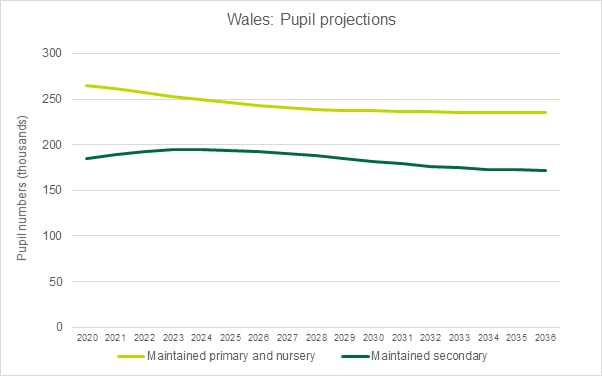
The current curriculum and assessment
This section attempts to capture in as summative a form as possible, the key characteristics of the main examinations currently available in Wales, including the curriculum focus, assessment methodology and coding languages preferred.
Curriculum focus:
- Understanding Computer Science
- Computational Thinking and Programming
- Software Development
Assessment approach:
- Written and on-screen examination and a practical project. The latter comprises 20% of the overall marks.
Language preferred:
- Basic derived languages (e.g. VB.NET, Small Basic, QBasic), C derived languages (e.g. C, C++, C#, PHP, Python, Pascal/Delphi
Curriculum focus:
- Fundamentals of Computer Science
- Practical Programming to Solve Problems
Assessment approach:
- Written and on-screen examination.
Language preferred:
- Visual Basic.NET, Python, Java
Curriculum focus:
- Programming and System Development
- Computer Architecture, Data, Communication and Applications
- Programmed Solution to a Problem
Assessment approach:
- Written and on-screen examination, plus a project that contributes 30% of the overall A level marks.
Language preferred:
- Visual Basic.NET, Python, Java
The teaching workforce
The most recent teaching workforce statistics from the Education Workforce Council (EWC) - the teacher registration authority in Wales[63] - offers a picture of relative workforce stability in computing and ICT although it is perhaps the case that ICT is being handled by non-specialists in many schools.
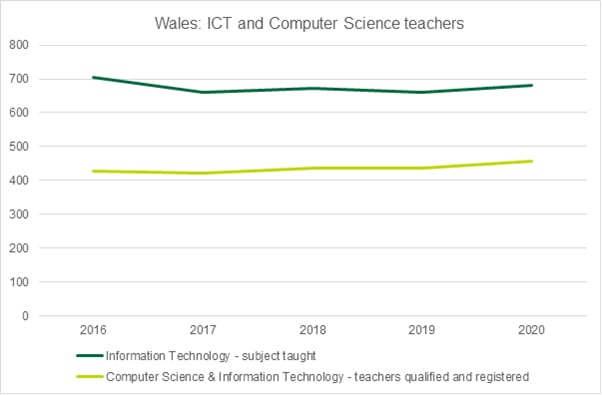
This data does reveal a particularly interesting phenomenon, which may be a result of the different definitions used to capture staff information on the EWC register. As the chart shows, there appears to be notably more teachers teaching ICT on the register than qualified to do so.
The recruitment of new Computer Science teachers continues to be a priority (it has been since 2013/14), with incentives offered (up to £20,000) to those who can train to teach Computer Science[64]. It has been especially challenging recruiting and retaining Welsh language Computer Science teachers, to support high-quality provision in Welsh medium schools.
The ITT/E targets for 2020/21 include 50 places for Information Technology, down from 54 in 2019/20. Initial teacher training/education targets in Wales are missed regularly, particularly in priority subjects such as STEM; this is a particular challenge in preparation for the new Curriculum for Wales, which will phase in from September 2022.
There are currently no formalised ways of developing additional skills qualifications for secondary teachers in Wales. The EWC promotes professional development for teachers, including signposting subject support. Teachers in Wales may also access training and development via a wide range of bilingual initiatives in computer science such as through the pan-Wales Technocamps10 project
There have been changes to the way in which ITT/E recruitment data is presented recently[65,66]. The intake targets show only Information Technology teachers for 2020/21 and 2021/22 (50 in each year). The recruitment data (actual intake) for 2020/21 is split into Information Technology (18 students) and Computer Science (9 students). This looks notably below the ambition set out for recruitment. It is currently not possible to present a coherent time series.
Attainment and participation
Uptake of ICT and Computer Science in Wales is mixed. The GCSE and A level interest in Computer Science is growing, and it is almost as popular as ICT at A level. ICT is dropping away at AS and A level, whilst uptake remains relatively stable at GCSE.
The Welsh Government data for GCSE and A-level outcomes merges Computer Science and ICT entry and attainment data and it is difficult to untangle the impact on the uptake figures of further education colleges and the independent sector.
Furthermore, with the proposed significant changes to the assessment and qualifications regime in Wales as part of the wider Curriculum for Wales reform (as per Qualifications Wales’ “Qualified for the Future”[67] work), there will be a wide offering of new Level 2 qualifications ready for learners from 2025 onwards.
For the sake of comparison, data for England, Northern Ireland, and Wales is drawn from JCQ annual statistical bulletins.
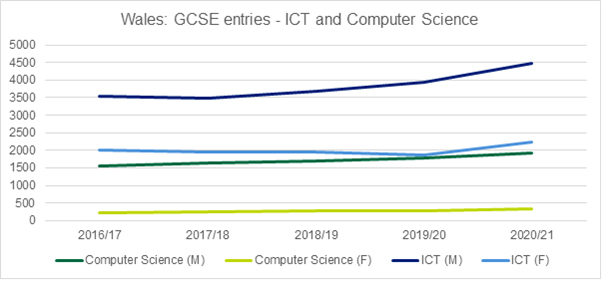
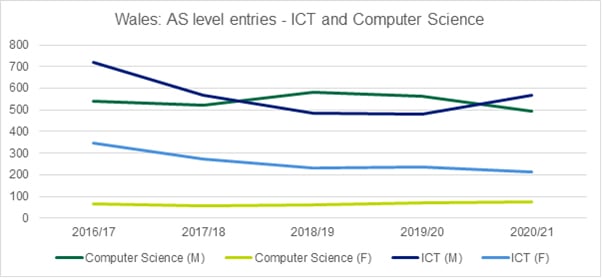
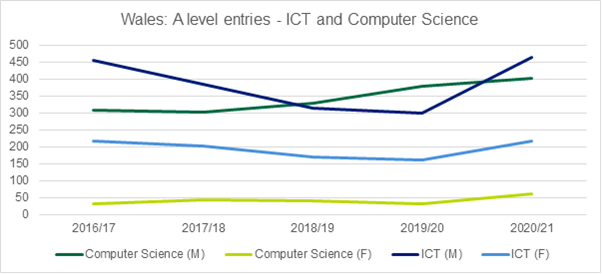
In 2021, JCQ reporting merged Applied A/AS levels into the main A/AS levels tables for data in Wales[68]. This may have contributed to the small increases in ICT in the most recent year.
The following charts set out Computer Science attainment by male and female candidates over the past five years (cumulative percentages).
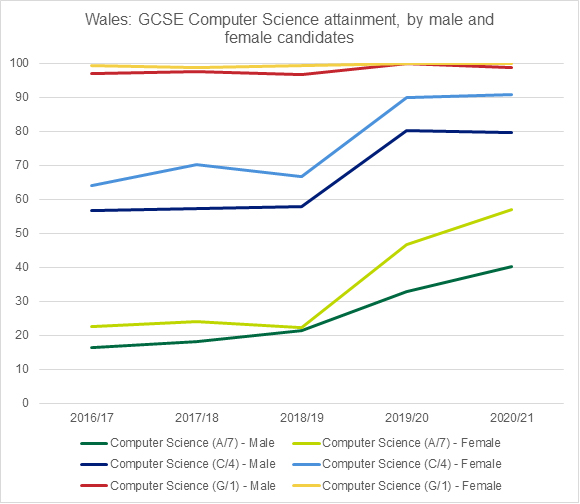
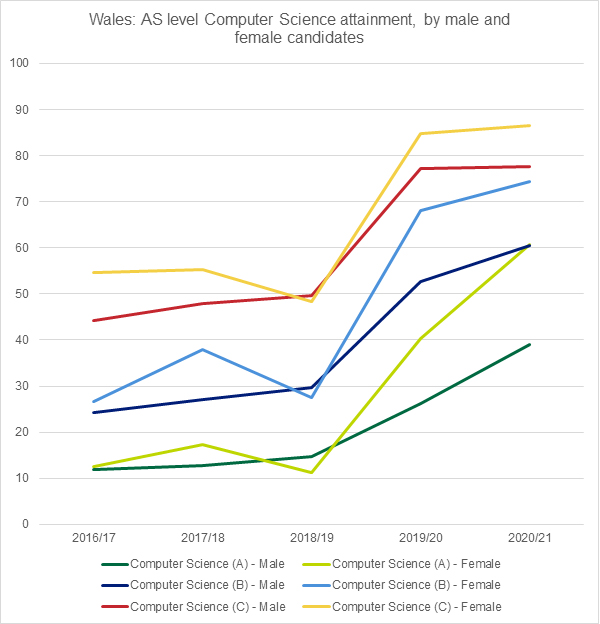
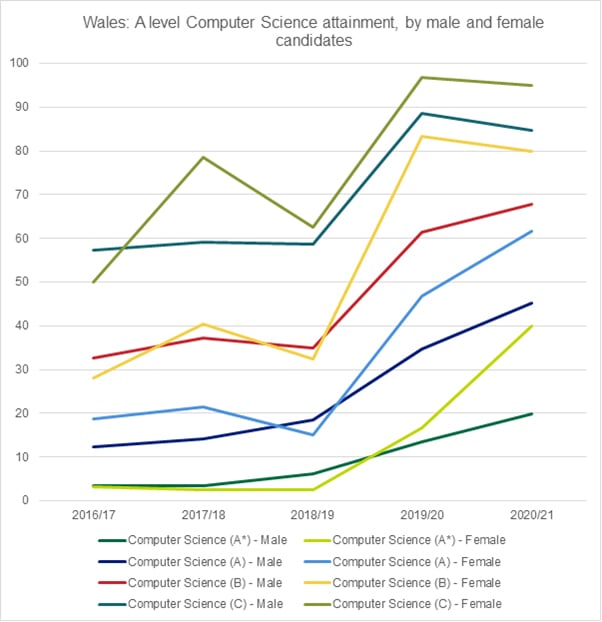
The male and female rates of interest are starkly different, with as many as 13 male participants to every female one for Computer Science A level whilst it is broadly two to one for ICT. Clearly, there is some strong signalling about the subject that is either galvanising or suppressing interest.
Computing GCSE accounts for 7% of the cohort (2,256 candidates), ICT GCSE for 20% if the cohort (6,704 candidates). Overall, ICT/Computing was the 10th most popular GCSE (19% of the cohort).
ICT/Computer Science was the 13th most popular A level in Wales in 2018/19 (5% of the cohort (462 Computing candidates, 681 ICT candidates)) with almost twice as many students taking Physics.
There is currently no published data illustrating uptake by young people from relatively advantaged and disadvantaged backgrounds, or by ethnicity.













